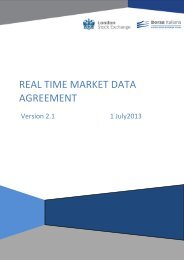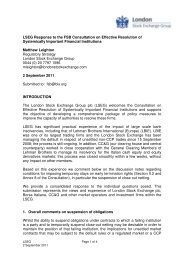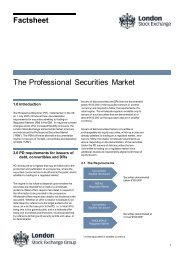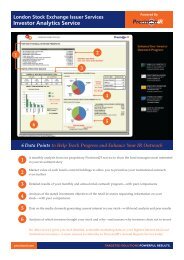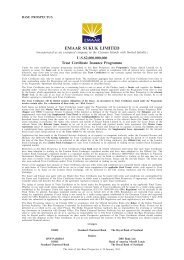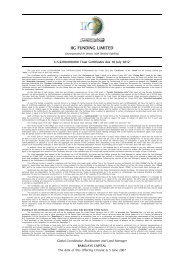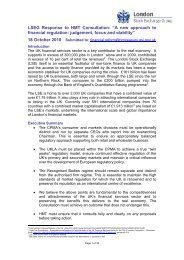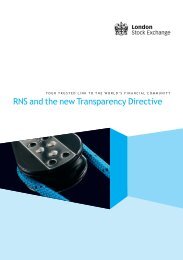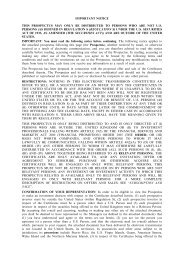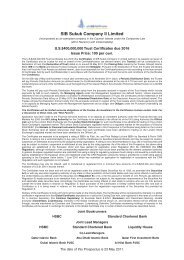NIG Prospectus - London Stock Exchange
NIG Prospectus - London Stock Exchange
NIG Prospectus - London Stock Exchange
You also want an ePaper? Increase the reach of your titles
YUMPU automatically turns print PDFs into web optimized ePapers that Google loves.
Level: 8 – From: 8 – Thursday, August 9, 2007 – 2:20 pm – mac5 – 3776 Section 10b : 3776 Section 10bpurchases or sales of financial assets that require delivery of assets within the time framegenerally established by regulation or convention in the market place concerned.Recognition and derecognition of financial assets and liabilitiesA financial asset or a financial liability is recognised when the group becomes a party to thecontractual provisions of the instrument. A financial asset (in whole or in part) is derecognisedeither when the group has transferred substantially all the risk and rewards of ownership or whenit has neither transferred nor retained substantially all the risks and rewards and when it no longerhas control over the asset or a proportion of the asset. A financial liability is derecognised whenthe obligation specified in the contract is discharged, cancelled or expired.Impairment of financial assetsAn assessment is made at each balance sheet date to determine whether there is objectiveevidence that a specific financial asset may be impaired. If such evidence exists, any impairmentloss is recognised in the consolidated statement of income. Impairment is determined as follows:(a)(b)For assets carried at fair value, impairment is the difference between cost and fair value; andFor assets carried at cost, impairment is the difference between cost and the present valueof future cash flows discounted at the current market rate of return for a similar financialasset.Reversal of impairment losses recognised in prior years is recorded when there is an indicationthat the impairment losses recognised for the financial asset no longer exist or have decreasedand the decrease can be related objectively to an event occurring after the impairment wasrecognised. Except for reversal of impairment losses related to equity instruments classified asavailable for sale, all other impairment reversals are recognised in the consolidated statement ofincome to the extent the carrying value of the asset does not exceed its amortised cost at thereversal date. Impairment reversals in respect of equity instruments classified as available for saleare recognised in the cumulative changes in fair value reserve in equity.Impairment of non-financial assetsThe group assesses at each reporting date whether there is an indication that an asset may beimpaired. If any such indication exists, or when annual impairment testing for an asset is required,the group makes an estimate of the asset’s recoverable amount. An asset’s recoverable amountis the higher of an asset’s or cash-generating unit’s fair value less costs to sell and its value in useand is determined for an individual asset, unless the asset does not generate cash inflows that arelargely independent of those from other assets or groups of assets and then its recoverableamount is assessed as part of the cash-generating unit to which it belongs. Where the carryingamount of an asset (or cash-generating unit) exceeds its recoverable amount, the asset (or cashgeneratingunit) is considered impaired and is written down to its recoverable amount byrecognising impairment loss in the consolidated income statement. In assessing value in use, theestimated future cash flows are discounted to their present value using a discount rate thatreflects current market assessments of the time value of money and the risks specific to the asset(or cash-generating unit). In determining fair value less costs to sell an appropriate valuation modelis used. These calculations are corroborated by available fair value indicators.An assessment is made at each reporting date as to whether there is any indication that previouslyrecognised impairment losses may no longer exist or may have decreased. If such indicationexists, the group makes an estimate of recoverable amount. A previously recognised impairmentloss is reversed only if there has been a change in the estimates used to determine the assetsrecoverable amount since the last impairment loss was recognised. If that is the case, the carryingamount of the asset is increased to its recoverable amount.F-26



